Chapter 9 Common Machines Introduction To Machines
We do different types of work in our daily life in homes, schools, colleges, offices, etc. You know that to do work, you need to apply some force. Some work needs less force and some work needs a large force.
When you push down the handle of a tubewell, water comes out from its mouth; you use a pair of scissors to cut a piece of paper or cloth; you drive a nail into a wooden block by hammering it with a hammer; to open the lid of a soft drink bottle you use a bottle- opener.
To dug soil you use a shovel; you use a pen or pencil for writing or drawing on paper; labourers use an inclined wooden plank to load heavy barrels upon a truck; a pulley is used to lift a load up, etc.
The underlined things are nothing but machines. Note that in each of these things you apply force on one part and the work is done at another part.
Read and Learn More WBBSE Notes For Class 6 General Science and Environment
Chapter 9 Common Machines Simple Machines
A simple machine is a mechanical device which is used to multiply the amount of applied force or to change the direction of force or both.
Simple machines make a job easier to do.
Types of simple machines
These are six types of simple machines:
1. Lever.
2. Inclined plane.
3. Screw.
4. Pulley.
5. Wheel and axle.
6. Wedge.
Chapter 9 Common Machines Complex Machines
A complex machine is made up from two or more simple machines. With the advent of civilization, various types of complex machines have been devised so far.
For example:
Sewing machines, bicycles, buses, taxis, tractors, printing machines, computers, etc.
Let us look at the following chart :
| Purpose of use | Simple machine | Complex machine |
| Sewing | Needle | Sewing machine |
| Writing | Pen or Pencil | Printing machine or Type Machine |
| Cutting paper | Blade, Knife, Scissors | Electric cutting machine |
| Cutting wood | Saw | Electric-cutter |
| Cutting soil | Spade | Tractor |
| Making holes in walls or in wood | Chisel | Drilling machine |
General terms related with simple machines :
- The force applied on a machine is called the effort (E).
- The force against which a machine works is called the load (L) or resistance.
- A fixed point situated on the body of a machine about which the machine turns while doing mechanical work is called the fulcrum (F).
- The shortest distance of the effort from the fulcrum is called the effort arm.
- The shortest distance of the load from the fulcrum is called the load arm.
Chapter 9 Common Machines Lever
A lever is the simplest machine that we are familiar with. It is a rigid rod which is capable of turning about a fixed point (or axis) called a fulcrum.
Types of levers :
Based upon the position of the fulcrum, load and the point of application of the effort, levers are classified into three groups:
Class, I lever: The fulcrum is in between the effort and the load.

Class II lever: The load is in between the fulcrum and the effort.

Class III lever: The effort is in between the fulcrum and the load.

Examples of class I lever :
A see-saw, a crowbar, a pair of scissors, a wire cutter, the handle of a tubewell, a spade, a beam balance, etc.

Examples of class II lever :
A nutcracker, a bottle opener, a wheelbarrow, a lemon squeezer, etc.
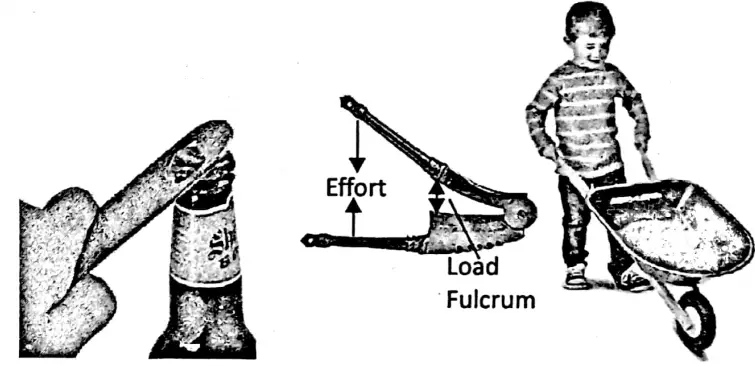
Examples of class III lever :
Forceps, a pair of tongs, a fishing rod, a broom, a human forearm, a bread-cutting knife, etc.

Chapter 9 Common Machines Concept Of Inclined Plane
An inclined plane is a slanted surface which is used to lift heavy loads by applying relatively little effort. See the shown alongside. It is easier to lift a load along an inclined plane than to lift it vertically.
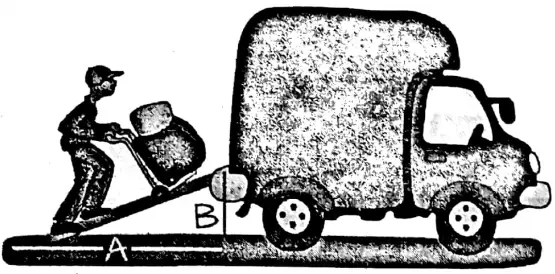
It has many applications in real life. A staircase, a ramp, a leaning ladder, a hilly road, a bridge or a flyover, etc. are examples of an inclined plane.
Chapter 9 Common Machines Screw
A screw generally looks like a nail having spiral grooves on the surface of a metal rod. The spiral ridges so-formed are called threads of the screw. These spiral ridges actually make an inclined plane.
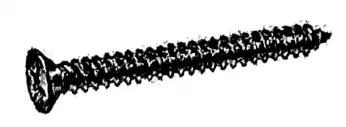
A screw is a combination of an inclined plane and a cylinder. It is easier to drive a screw into a wooden plank with a screwdriver than by hammering. That’s why it takes less force to drive a screw into wood than to drive a nail.
Chapter 9 Common Machines Pulley
A pulley is a simple machine to lift a load by applying an effort in a convenient and suitable direction. You have seen that a bucket of water from a well can easily be raised with a pulley by applying the effort in the downward direction.
A picture of it is shown in. It is nothing but a grooved wheel through which a rope runs.
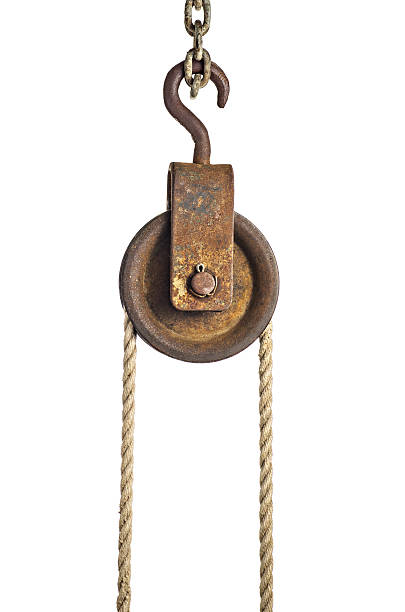
Note: A pulley is used for lifting a load up.
Chapter 9 Common Machines Wheel And Axle
Take a circular wheel having a hole at its centre. Through the centre, attach a pen/pencil/anything like this firmly to it. This forms a wheel and axle arrangement.
Thus, the arrangement consists of a big cylinder joined with a small cylinder, The big cylinder is called the wheel and the small cylinder is called the axle.
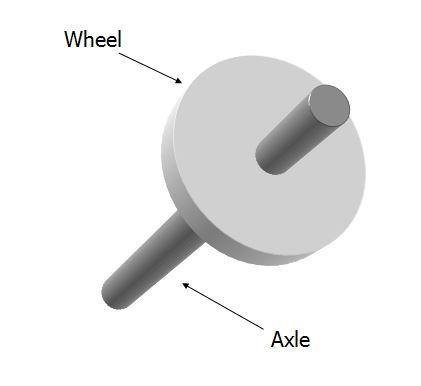
If you rotate the wheel, you see the axle (pen/pencil) also rotate. Ropes are wound around the wheel and the axle in opposite directions.
In general, the rope round over the axle is tied to the load, while at the other end of the rope round over the wheel the effort is applied. It is clear that the wheel and axle arrangement takes less effort to move something.
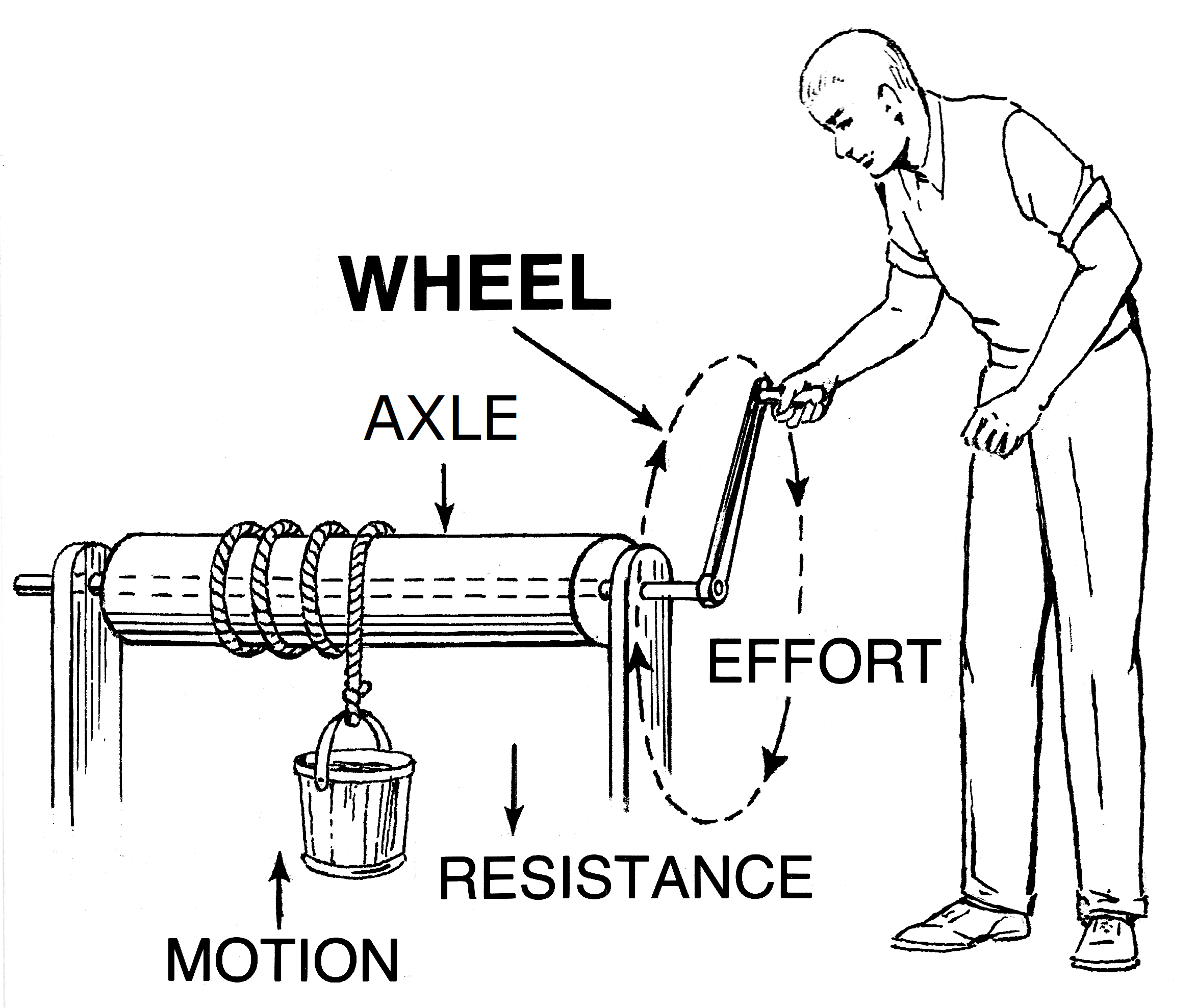
There are many applications of this arrangement. In a screwdriver, the thick handle works as a wheel, while the metal rod attached to it functions as an axle. Similarly, a water tap, a door nob, a steering wheel, wheels of a car, etc. are other examples.

Chapter 9 Common Machines Maintenance Of Machines
A machine needs to be properly maintained for its trouble-free, efficient and longer use.
We can take the following ways:
- Most of the parts of a machine are made of iron. To protect these parts from rusting they should be painted.
- Moving parts of a machine suffer wear and tear due to friction. Such parts should be lubricated with good-quality of lubricating oil to reduce friction.
- When a machine is not in use, it should be covered to protect it from dirt and dust.
- A machine should be cleaned at regular intervals.
Following these ways, we can increase the life of a machine.
WBBSE Notes For Class 6 General Science and Environment
-
- Chapter 1 Interdependence of Organisms and the Environment
- Chapter 2 Phenomena Around Us
- Chapter 3 Element, Compound and Mixture
- Chapter 4 Rocks and Minerals
- Chapter 5 Measurement
- Chapter 6 Primary Concept of Force and Energy
- Chapter 7 Statics and Dynamics of Fluid
- Chapter 8 The Human BodyChapter 9 Common Machines
- Chapter 10 Biodiversity and its Classification
- Chapter 11 Habits and Habitats of Some Important Animals
- Chapter 12 Waste Products

